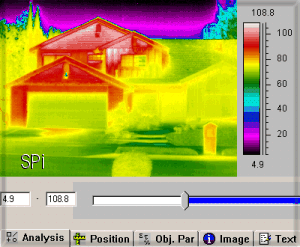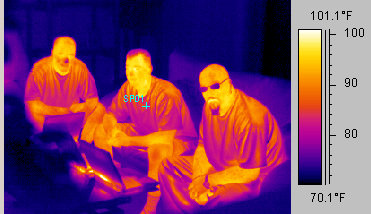How to Install Batteries on the T14-X Thermal Rifle Scope
This video shows the right way to install batteries in the T14x scope. It’s easy once you know how.
Back to Knowledge Base
How Thermal Imaging Works
 Thermal images cannot see through walls, although you can gather much information about the inside of the wall as well as what is happening on the other side of the wall. For example you would not be able to see people and plants involved in an illegal indoor growing operation from the outside of the building. You would be able to see and monitor the heat escaping from the building that would be a telltale sign of an illicit growing operation. Click here for legal cases involving thermal infrared for narcotics detection
Thermal images cannot see through walls, although you can gather much information about the inside of the wall as well as what is happening on the other side of the wall. For example you would not be able to see people and plants involved in an illegal indoor growing operation from the outside of the building. You would be able to see and monitor the heat escaping from the building that would be a telltale sign of an illicit growing operation. Click here for legal cases involving thermal infrared for narcotics detection
You would also be able to see things like studs inside the walls, or damaged insulation in roofing applications. You cannot hide from thermal imaging by covering yourself in mud to blend in like that movie tough guy. This might work momentarily, but infrared “heat” energy transfers well when objects are touching. Your body heat would quickly warm your camouflage resulting in a thermal image. We hope that dispels a few of the most common questions regarding infrared energy. Thermal imagers in Hollywood and in real life are very different. The remainder of this paper will focus on the real life thermal imagers and how they work.
Thermal energy is transmitted in the infrared wavelength ( 1 micron to 100 microns ). You can see by the image above that thermal energy is closely related to visible light in that it travels in a wave. The human eye can only see the narrow middle band of visible light that encompasses all the colors of light in the rainbow. Thermal infrared imagers translate the energy transmitted in the infrared wavelength into data that can be processed into a visible light spectrum video display. Visible light is dependent on a light source ( the sun or artificial ) reflecting off an object to be received by our eyes. Remember, all objects above 0 degrees Kelvin emit thermal infrared energy so thermal imagers can passively see all objects regardless of ambient light. This can give you an enormous advantage. Thermal infrared imaging performs in a wider range of environments than other night vision technologies. Additionally, IR devices can serve your inspection needs at night or in broad daylight.
 The image on the left shows two adults and a child through an infrared thermal imager. After a minute of sitting on the couch the thermal infrared energy of the people is transferred and stored in the couch until they get up. The image on the right illustrates the fact that all objects radiate heat. The heat from their bodies that transferred to the couch is now being emitted from the couch and displayed on a thermal imaging device. No visual light technology can record this type of data. The properties of heat transmission are more than an interesting novelty, this information can prove useful in a variety of applications. Law enforcement applications include criminal tracking, land/airborne surveillance, drug facility detection, or vehicles which have been recently operated all from a safe distance, industrial users can detect flaws in manufacturing or weakened insulators, fire safety professionals can detect full vs. empty flammable storage containers, and forestry workers can easily track game or poachers. Other applications include non destructive testing, process control, predictive/preventative maintenance, building/factory diagnostics, energy audits, roofing/insulation inspection, insurance fraud prevention, veterinary/human medical imaging, border patrol, remote security monitoring, and many more applications being discovered.
The image on the left shows two adults and a child through an infrared thermal imager. After a minute of sitting on the couch the thermal infrared energy of the people is transferred and stored in the couch until they get up. The image on the right illustrates the fact that all objects radiate heat. The heat from their bodies that transferred to the couch is now being emitted from the couch and displayed on a thermal imaging device. No visual light technology can record this type of data. The properties of heat transmission are more than an interesting novelty, this information can prove useful in a variety of applications. Law enforcement applications include criminal tracking, land/airborne surveillance, drug facility detection, or vehicles which have been recently operated all from a safe distance, industrial users can detect flaws in manufacturing or weakened insulators, fire safety professionals can detect full vs. empty flammable storage containers, and forestry workers can easily track game or poachers. Other applications include non destructive testing, process control, predictive/preventative maintenance, building/factory diagnostics, energy audits, roofing/insulation inspection, insurance fraud prevention, veterinary/human medical imaging, border patrol, remote security monitoring, and many more applications being discovered.
Thermal infrared imagers come in different configurations to suit your specific needs. Some imagers are designed to give you actual temperature measurement of the scene along with a color video representation. This type of imager is called “radiometric” and is used mostly for industrial ( predictive maintenance, process control, R&D ) and medical ( human & veterinary ) applications. Other imagers are designed primarily for surveillance and / or target acquisition environments. These units can be either hand held or fixed mount remote installations. The chief differences in surveillance units is going to be the optical components and the resolution of the imager. High end units for surveillance and target acquisition scenarios are capable of human detection at over 1 mile and vehicle detection at over 5 miles. Another type of detector is the aerial surveillance mounted thermal imager. These units are mounted to aircraft in gyro stabilized all weather housings. Typically they are remote controlled and are either alone or paired with a CCD TV camera. Primarily these units are used by law enforcement agencies and electronic news gathering teams.
